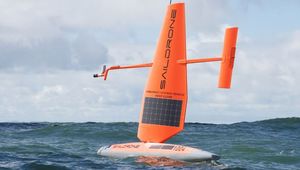XENSIV™ PAS CO2 Sensor2Go Evaluation Kit
Evaluation Kit developed to enable swift evaluation of Infineon’s Photo Acoustic Spectroscopy (PAS) CO2 sensor.
Technical Specifications
| Board Type | Evaluation Board |
| Family | XENSIV™ CO2 sensors |
| Interfaces | I2C, UART, and PWM |
| Supply Voltage | 3.3 - 12 |
| Operating range | 0 - 32000 |
| Accuracy | ± (30 ppm +3%) of reading between 400 ppm - 5000 ppm |
| Applications | Home appliances, Smart home IoT devices, Agriculture/ Greenhouses, In-cabin air quality monitoring unit |
Overview
Measuring CO2 allows users to optimize comfort, energy efficiency, and health as it is a key indicator of indoor air quality. XENSIV™ PAS CO2 Sensor2Go Evaluation Kit has been developed to enable swift evaluation of Infineon’s Photo Acoustic Spectroscopy (PAS) CO2 sensor. The evaluation kit can be combined with the PAS CO2 Mini Evaluation Board. The Sensor2Go Evaluation Kit comes up with XENSIV™ PAS CO2 Evaluation Motherboard, XENSIV™ PAS CO2 mini evaluation board, a micro-USB cable, a graphical user interface (GUI), and software via Infineon toolbox. The intended audience for this module is system engineers, application engineers, and developers of an application where the XENSIV™ PAS CO2 mini-evaluation board will be integrated.
Photoacoustic Spectroscopy (PAS) Principal
The photoacoustic principle involves the formation of sound waves due to pressure changes following light absorption in a material sample. Microphones quantify the resultant sound signal. Light intensity must be different to obtain this effect. The foundation of a PAS gas sensor is the idea that gasses absorb light at a particular infrared wavelength. CO2 molecules strongly absorb light at a wavelength (λ = 4.2 μm).
In PAS, light pulses from an infrared source pass through an optical filter specifically tuned to the CO2 absorption wavelength. As a result of absorbing the filtered light at each pulse, the CO2 molecules inside the measurement chamber shake and generate a pressure wave.
The acoustic detector, optimized for low-frequency operation, detects the sound, and the microcontroller changes the output into a CO2 concentration reading. The absorption chamber is acoustically insulated from outside noise to deliver accurate CO2 sensing readings.
XENSIV™ PAS CO2 Sensor2Go Evaluation Kit Features
XENSIV™ PAS CO2 Sensor2Go Evaluation Kit is a plug-and-play module that allows direct connection to a PC via micro-USB cable. The kit enables the key functionalities of the sensor to the user. The PAS CO2 sensor has a simple design, SMD capability, and direct ppm readings, allowing quick integration into users' systems in normal or complex applications.
Users can access the sensor history using this evaluation kit by logging in to an application. The device can also be accessed via I2C. All the power supplies are generated on board. The power management unit ensures stable 12V for the light source. The sensor allows users to monitor, analyze, and improve the air quality around them while consuming less energy. The sensor is ideal for weather stations, thermostats, air purifiers, personal assistants, and building automation.
Getting Started with XENSIV™ PAS CO2 Sensor2Go Evaluation Kit
Step 1: Connect the Hardware
Connect the mini-evaluation board to the motherboard.
Step 2: Download the GUI
Uninstall any previous version of the same GUI before installing the XENSIV™ PAS CO2 Sensor2Go GUI. Graphical User Interface can be downloaded from the Infineon toolbox.
Step 3: Install the GUI
Install the GUI by performing all the necessary steps.
Step 4: Connect the Evaluation Kit
Connect the evaluation kit to your PC using a micro USB cable.
Step 5: Start Using It
Once the sensor is connected, start the data acquisition by pressing connect button. XENSIV™ PAS CO2 Sensor2Go GUI supports connection to multiple PAS CO2 devices (max 10). After pressing Connect button, all the connected devices will be listed in a tree view in the expandable CO2 devices pane.
Applications
XENSIV™ PAS CO2 Sensor2Go Evaluation Kit has vast applications in air quality monitoring and demand-controlled ventilation. It is also used as a major component in HVAC (heating, Ventilation, Air Conditioning) in residential and commercial areas. It is also used in lighting, air quality devices, smart thermostats, smart agriculture, and greenhouses.









